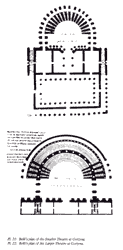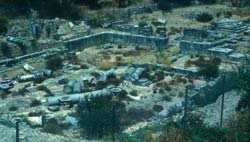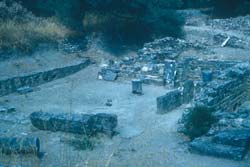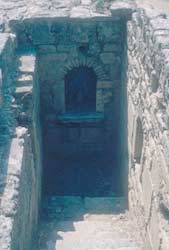Development of Gortyn under the Romans
 (Click to enlarge) © Thames and Hudson |
While Phaistos had been dealt with, rivalry with Knossos continued until the arrival of the Romans. Gortyn found itself on the winning side here (and Knossos on the losing). Knossos was destroyed, and a new Roman settlement put there, while Gortyn became the capital of the new Roman province of Crete-Cyrene.
The position of Gortyn in the Roman empire had major consequences for its buildings. Under Rome, democracy became a matter of form, and assemblies gradually ceased to exercise significant power, though equally Greek ‘heritage’ was highly valued. The fate of Gortyn's inscribed law code fits into this picture. The original wall on which the laws had been inscribed was reassembled ca. AD 100 to form the rear wall of a new *Odeion. This building probably had two functions: as a meeting place for the city's Council (which exercised the power once wielded by its Assembly), and as a place for public performances.
 (Click to enlarge) © De Luca |
As the centre of Roman administration of Crete, Gortyn also acquired new Roman buildings.
 Gortyn: Praetorium (1982). © Lucia Nixon |
The most striking of these is the *Praetorium (‘Government House’), where the governor conducted his legal and administrative business; there were probably two Roman period phases, one in the early first century AD, and the second in the second century AD.
 Plan by Onorio Belli of one of the Roman theatres at Gortyn (1586) © Aris and Phillips |
In addition, Gortyn (like other Greek cities in this period) built new buildings of a Roman cast. Its two *theatres date to the Roman period, and their design follows the fashions of the day that emanated from Rome. Theatres were used both for public meetings and for performances.
The *circus (for chariot racing) and the *amphitheatre (for wild beast shows) were forms not found in the Greek world before the Roman conquest, and were then found only in particularly 'Roman' places.
 Gortyn: elevation of Praetorium fountain house (Phase I) (1984). © De Luca |
The city also benefited from a new water supply. A new *aqueduct was built to bring water to Gortyn (again characteristic of the period). This water was used in part for a magnificent Nymphaeum (fountain-house) beside the Praetorium, and in part for public *baths (which were another import to the Greek world from Rome).
 Gortyn: temple of Apollo (Pythion), looking NE. Constructed 7th cent. BC and Hellenistic, completed by Romans (1982). © Lucia Nixon |
Religious life of the city was focused on the *temple of Apollo Pythios on the plain.
 (Click to enlarge) © De Luca |
The sanctuary on the Akropolis has not produced evidence from the Roman period. A Hellenistic *sanctuary to the Egyptian gods Serapis and Isis was rebuilt in the first-second century AD by a local woman.
 Gortyn: sanctuary of Isis and Serapis (1982). © Lucia Nixon |
Sanctuaries to these gods are found in the Greek world from the Hellenistic period onwards. This is the only one excavated on Crete.
 Gortyn: sanctuary of Isis and Serapis, looking west at cistern on south side (1982). © Lucia Nixon |
On the east side of the Praetorium was a new *temple, in Roman style on a high base, that was probably dedicated to the deified Emperors (another common phenomenon in Greek cities in this period; the cult was initiated and organised by Greek cities, though the practice was not unwelcome to the Roman authorities).
In the Late Roman period Gortyn continued to prosper, despite a number of earthquakes which caused severe local damage. The Praetorium was rebuilt AD 381-381, and the Odeion was redesigned.
 Gortyn: church of Agios Titos (1981). © Lucia Nixon |
Christians are known at Gortyn from the earliest times (Letter to Titus ascribed to St Paul), but (as elsewhere in the empire) leave no material traces until the Late Roman period, when Christianity became the official religion of the empire. In the sixth to seventh centuries the large *church to St Titus was built.
This is the best preserved and most important of the Late Roman churches on Crete. It is a large (31 x 19m), three-aisled church, modelled on churches in Constantinople, and may have been stimulated (even paid for) by the Emperor Heraclius (AD 610-641). In this period six other *churches were built. Four of these were built into remains of pagan temples (two on the Akropolis, and one in the temple to Apollo Pythios).